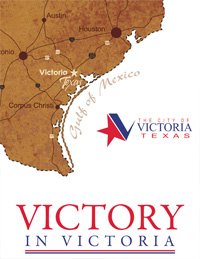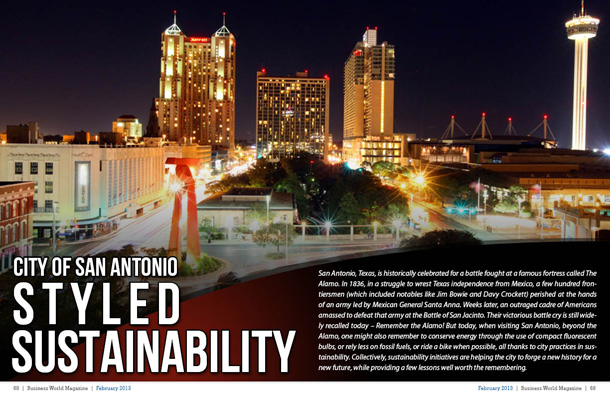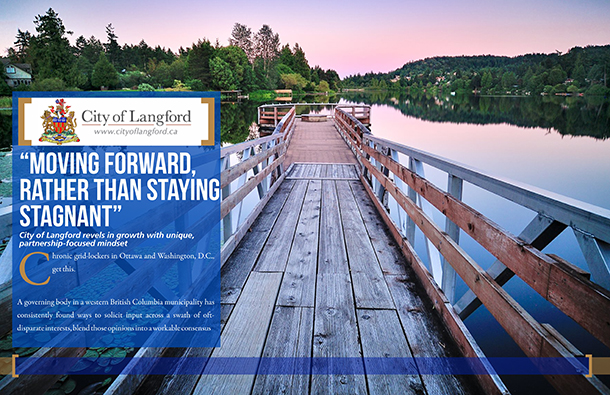Victory in Victoria

The Roman Emperor Marcus Aurelius once said, “The secret of all victory lies in the organization of the non-obvious.†That sentiment certainly applies in accounting of the not-so-secret success of an organization, and the organizational infrastructure, that has compelled a Texas community to achieve obvious victories in economic development objectives. Â
The Texas City of Victoria is situated some 30 miles inland from the Gulf of Mexico where it graces a seven county region known as “The Golden Crescent.†Due to its proximity to denser populations in Austin, Corpus Christi, Houston and San Antonio (each respectively directed a mere two-hour or less drive away) Victoria has been colloquially called “The Crossroads†as it comprises a retail trade corridor catering to more than 250,000 consumers; in itself, Victoria’s population is approximately 65,000 people. Historically, this community emerged from the North America expeditions of French Explorer La Salle who, in 1688, established a French colony and fortification known as Fort St. Louis. During the 18th Century, Spain would establish a mission in this same vicinity; in fact, Victoria is home to St. Mary’s Church, the second-oldest Roman Catholic denomination in Texas, yet the very first to be canonically recognized. Victoria is also where the Mexican government would create the most vital of any colony it had ever established in its effort to rule the Republic of Texas. Named for General Guadalupe Victoria (the first president of independent Mexico), Victoria once served as the very government headquarters of The Republic of the Rio Grande. This is a community with a wealth of history, yet when it comes to Victoria’s fiscal prosperity in the future, there are even more significant historical milestones whose relevance in the modern era merits recognition.
Dale Fowler, the Certified Economic Developer who serves as President of the Victoria Economic Development Corporation, explains that 15 years ago, community leaders came together with corporate stakeholders and representatives from other community organizations to reevaluate what was being done to not only attract new business to the region, but also what was being done to make the community more conducive for business already there. For more than 8 months, strategies were discussed and analyzed for impact, even as challenges and opportunities were identified. In terms of challenges, Fowler says, “We quickly realized we didn’t have ready sites. When you’re trying to recruit new business, it will be difficult if you don’t have a place ready to go with infrastructure.â€
Among the EDC’s earliest successes was developing an industrial park encompassing 320-acres of land within City limits. Approximately $3.4 million was spent by the community for land and the EDC secured a $1.6 million EDA grant for upgrading the road, putting in streetlights as well as storm water retention and drainage systems. When all was done, the community had what appeared to be four-lanes of beautiful paved boulevard winding between two pastures. It sat like this for the next several years, necessitating upkeep of landscaping and road maintenance, while Fowler’s EDC was diligently working behind the scenes to market that real estate to industrial prospects. For all his meetings and negotiations in other markets, over time, there would be certain challenges also confronted in his home market. People had begun to speculate about the rationale behind that industrial park. It became a political issue, with some suggesting it made no sense to allow a perfectly good spot of ground to go unused when it could be divvied-up into small parcels to accommodate small enterprise, but the EDC encouraged resistance to such proposals. Like that famous field of dreams, Fowler maintained a positive “if you build it, they will come†posture. Whatever doubt may have once existed, the fact remains that the Victoria EDC has ultimately proven its point. Caterpillar Inc., the $70 billion manufacturer of mechanical marvels critical to the industries of agricultural, energy, transportation and construction, has since selected Victoria as the new site for their manufacturing of hydraulic excavators. Now manufactured in Victoria, TX, these excavators range from 11 to 49 tons of machinery crucial to the moving of dirt and Caterpillar moved more than $200 million to Victoria to create the 1.3 million square-feet of required operational space, essentially taking-up over half the available acreage offered by the industrial park. This has already led to the creation of more than 400 new jobs, but when it reaches full production, Caterpillar anticipates the Victoria facility will employ 800 and upwards.
Success is said to breed success. In this instance, the EDC developed another 100 acres of land at a site located just across the street from the new Caterpillar facility. This site will soon serve as home to a new division of Ken Garner Manufacturing, a Tennessee-based enterprise recognized as the leading industry producer of counterweights crucial in the manufacturing of heavy duty equipment – particularly, the excavators produced by Caterpillar.
Benefits for Business
Beyond setting aside land, the Victoria EDC helped spur other incentives which not only posed a benefit for new business operations, but also benefitted businesses already existing in the community. For example, the community already had what were known as enterprise zones. For businesses that operate in such zones, there are certain tax benefits and allowances which provide fast-track permitting. Expanding on that line of incentive, the Caterpillar site has been deemed as a Foreign Trade Zone (FTZ 155) which accommodates similar benefits. The Caterpillar site is also located only 12 miles from the Port of Victoria, a facility that is utilized by barges for the shipping of cargo along the Gulf Intracoastal Waterway, but also enables shipping by rail. Someday the Port hopes to have companies such as Caterpillar shipping containers directly to Victoria by barge.
Trucks can only carry so much over the road, whereas barge containers can accommodate a larger load. In this case, goods could, say, arrive in Houston and be delivered by barge to the Port of Victoria for less than what it would cost to ship over the road. The EDC helped push for legislative allowance for the port to have heavy permitting, which allows for the shipping of goods without having to make changes to roads or jump time-consuming regulatory hurdles to get good from Point A to Point B. The EDC also helped secure Free Port Tax Exemption, a benefit that allows companies to have a tax break on inventory which comes in and then is shipped outside the state within 175 days. All companies who had goods coming and going in such fashion were previously being taxed on it. Fowler says it took over a year (which he considers record time) to secure the Free Port Exemption, but that not only benefits Caterpillar, but all companies across the board, in fact, for one local company already established in Victoria, the savings amount to more than $500,000 a year. Fowler says it was all in the timing. “We have to have this big tax base coming into our community which helped offset any risk from no longer collecting the taxes we were.â€
The Port of Victoria operations are, as Fowler says, another example of visionary leadership and proactive planning for the future. Conceived more than a 60 years ago, Fowler says, “For those guys who thought about dredging a 35 mile-long canal to create a waterway that leads to our community… that took a lot of guts and vision to do that, but today we’re really reaping benefits because they did.â€
As for the implementing of new incentives allowing for quicker permitting and tax breaks, Fowler says the development of such infrastructure helps demonstrate the cooperation fostered between government and business. “So much of economic development is about relationships, and when a company arrives, there’s no time to develop relationships at that point, they have to be already in place.â€
Those relationships not only involve forces of government, but also those who work in education and are tasked with the responsibility of training workforce. Fowler says Post-secondary education is critical. “You have to have a labor force, but that doesn’t just mean having people – there has to be an ability to train them,†he says. Again, Victoria has several advantages on this front. For example, University of Houston-Victoria campus which once only served as a school for upper classmen has transitioned to a full-fledged four-year school. To accommodate increasing student enrollments, the university has converted two former hotels into dorm facilities in addition to the construction of new dorms, and Fowler says as the school brings more young people into the community, there is increasing potential that some may actually stay upon finishing school, thereby adding to the workforce.
Another exciting development involves the near century old institution known as Victoria College. A long time partner with local business through its providing of vocational training and certifications crucial in a range of industries, the EDC along with other community leaders secured a deal that is now enabling Victoria College to develop a new industrial training center that will be located on 16 acres of the industrial park. As Fowler affirms, “This strengthens our ability to train workers in all industries.â€
And to be sure, there are other industries which have long figured in Victoria’s economic strength. EDC Vice President of Marketing Adrian Cannady says a former economic impact study identified that the region’s healthcare industry equates to a billion dollars of annual revenue. Cannady says he has been especially encouraged to see how the medical community is responding to growth, and in one case, a school is advancing in delivery of professional development services crucial to healthcare. Texas A&M University has recently announced the establishing of a new residency program through a partnership with DeTar Healthcare System which has acute care hospitals in Victoria.
The petrochemical industry has been a major player in the region for years too. Victoria is one of the larger communities in the vicinity of Eagle Ford Shale. In the development of oil and gas, Eagle Ford Shale not only represents the largest single economic development in the history of Texas, but the largest industry development in the world in terms of capital invested. This year, more than $30 billion will be invested in this enterprise. Though Victoria isn’t located at the epicenter of all those mining operations, Fowler says industries such as Eagle Ford Shale typically spur the growth of other businesses, new jobs, new housing, which all again adds to the economic vitality of the region.
Fowler observes that only five years ago, there were many people speculating that there would never be another major petrochemical facility complementing economic activity in this gulf coast region, but all of that has changed. Last month, the delivery of more than 1.3 million barrels of crude was accommodated by operations at the Port of Victoria, in fact, for the last few months; the port has averaged more than a million barrels of monthly transit. Fowler says he is also seeing expansion occurring among the major petrochemical companies in the area. Formosa Plastics, a driving economic force for more than 30 years, is currently undertaking a $1.7billion expansion project in the county just adjacent to Victoria.
With businesses growing, educational and employment opportunities increasing, and new companies coming to Victoria, there’s little wonder as to why the EDC, as well as all others in Victoria, are especially excited about the economic future of this Texas community.
Not one to rest on laurels, Fowler says the EDC is still focused on moving ahead and capitalizing on other opportunities to further bolster economic development. He believes there is possibility to grow businesses in the automotive industry, particularly among those who supply parts to manufacturers. Victoria is in the middle of a corridor between auto manufacturing operations in San Antonio and Mexico. The EDC is also active with an initiative known as TexasOne, a state marketing initiative that helps promote the development of new business in the state. Victoria EDC has ventured to communities in New York, California and even Germany and Japan to promote opportunities for business in Texas. “Coming to Texas is great, but eventually, you got to narrow it down to where in Texas,†says Fowler, adding that Victoria is the ideal location.
Given the incentives, the cooperation, the workforce and everything that speaks to this community’s willingness to work with business, Fowler is confident about Victoria’s future. “We believe in luck, but you know what luck is…†says Fowler. “That’s when preparation meets opportunity. There are things going on here today because leadership was willing to put it in place years ago.â€
To further validate Fowler’s assertions, one need only consider remarks recently made by Caterpillar Chairman and CEO Doug Oberhelman. In an effort to manufacture more of their product closer to their market, Oberhelman says, “We needed somewhere we could go with a good workforce, with a very friendly business climate, and a group of people that really wanted us here… with taxes, regulations, all the things people talk about that are attractive, we needed and we found it here… the Victoria area was very good.â€
For more information, please visit their website at: Â The Texas City of Victoria








